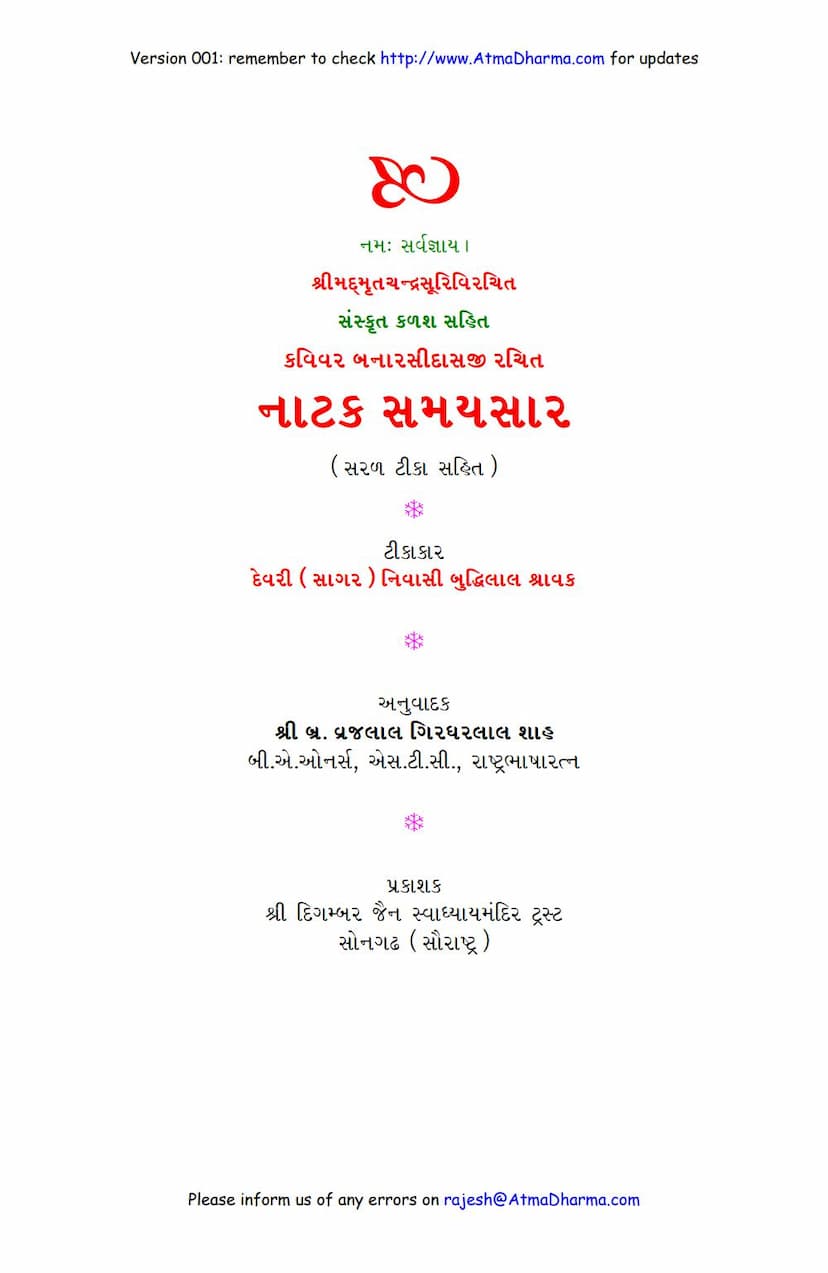Natak Samaysara
Added to library: September 2, 2025

Summary
The book "Naatak Samaysara" by Banarasidas, published by Digambar Jain Swadhyay Mandir Trust, is a significant work in Jain spiritual literature. It is a dramatic presentation of the "Samaysara," a foundational text in Jain philosophy, originally authored by Acharya Kundakunda and commented upon by Acharya Amritchandra. Banarasidas, a poet and scholar, adapted this profound spiritual treatise into a narrative play, making its intricate concepts more accessible.
Here's a comprehensive summary based on the provided pages:
Core Subject Matter:
The "Naatak Samaysara" delves into the profound Jain philosophy of the soul's true nature and its liberation. It primarily focuses on:
- Aatma (Soul): The book emphasizes the soul's inherent purity, its distinction from the physical body and other non-soul substances, and its eternal, formless, and omniscient nature.
- Bondage and Liberation: It explains how the soul becomes bound to worldly existence through karma, attachment, and ignorance, and how liberation (Moksha) is achieved by discerning the true nature of the soul (soul-substance) from non-soul substances, through right faith, right knowledge, and right conduct (Ratnatraya).
- The Path to Liberation: The text meticulously details the path to spiritual liberation, often referencing the concepts of:
- Naya (Standpoints): Explaining the importance of understanding reality from different perspectives like Nischaya (absolute) and Vyavahara (conventional) naya.
- Bondage (Bandha): Describing the process of karma accumulation through passions (kashayas), influx of karmas (Asrava), and bondage (Bandha).
- Cessation of Bondage (Samvara): Detailing how the influx of karmas is stopped through right conduct, restraint, and awareness.
- Eradication of Karma (Nirjara): Explaining the shedding of past karma through austerities and spiritual practices.
- Liberation (Moksha): Describing the state of the soul when freed from all karmic bondage, attaining omniscience and eternal bliss.
Structure and Content:
The book, as indicated by the detailed table of contents (pages 6-16), is structured into twelve main sections (Adhikaras), followed by further chapters and sub-topics. These sections progressively guide the reader through the Jain spiritual path:
- Jiva (Soul): Description of the soul's nature, its attributes, and its distinction from non-soul substances.
- Ajiva (Non-soul): Explanation of the categories of non-soul substances like matter, space, dharma, adharma, and time.
- Karta-Karma-Kriya (Doer, Action, Deed): Philosophical exploration of who the true doer and enjoyer is, emphasizing the soul's inherent non-action (Aakarta) in reality, despite empirical perceptions.
- Punya-Papa (Merit and Demerit): Discusses how actions, whether perceived as meritorious (punya) or demeritorious (papa), are ultimately karmic bondage and equally detrimental to liberation if attached to.
- Asrava (Influx of Karma): Explains how passions and activities lead to the influx of karmas.
- Samvara (Cessation of Karma Influx): Details the practices and states that stop the influx of karmas, such as mindfulness, vows, and restraints.
- Nirjara (Shedding of Karma): Describes the process of burning off accumulated karma through austerities and spiritual effort.
- Bandha (Bondage): Explains how karma binds the soul.
- Moksha (Liberation): Describes the ultimate goal of liberation and the soul's state of eternal freedom.
- Sarvavishuddhi (Complete Purity): Focuses on the pure state of the soul, free from all impurities.
- Syadvada (The Doctrine of Manifold Aspects): Explains the Jain principle of viewing reality from multiple perspectives to arrive at a complete understanding.
- Sadhyasadhaka (Goal and Path): Discusses the ultimate goal of liberation and the path to achieve it.
- Chaturdasha Gunasthana (The Fourteen Stages of Spiritual Progress): Details the fourteen stages of spiritual evolution a soul undergoes on its path to liberation.
Key Philosophical Concepts:
- Anekantavada: The principle of manifold aspects, particularly as expounded through Syadvada, which suggests that reality can be understood from multiple viewpoints.
- Naya: The different standpoints (Nishchaya Naya for absolute truth and Vyavahara Naya for conventional truth) are crucial for understanding the soul.
- Aparigraha: Non-attachment to possessions, including the body and mind, is highlighted as essential.
- Self-Realization (Atma-Anubhava): The text strongly advocates for direct experience of the soul's true nature through meditation and introspection.
- Distinction between Soul and Non-Soul: A central theme is the clear differentiation between the soul (Jiva) and non-soul substances (Ajiva) like matter, to overcome delusion.
Literary Style and Presentation:
- Dramatic Form: Banarasidas masterfully uses a dramatic format, often employing dialogues between a Guru and a disciple, to explain complex philosophical points. This makes the text engaging and easier to grasp.
- Poetic Language: The original work is in verse, filled with rich metaphors, analogies, and devotional poetry, particularly in the invocatory prayers to the Tirthankaras and the exposition of spiritual concepts.
- Accessibility: While the original Samaysara is highly philosophical, Banarasidas's dramatic and poetic adaptation, along with the commentary and translation (Gujarati in this case), aims to make the essence of the teachings accessible to a wider audience. The introductory pages mention a "simple commentary" (Saral Teeka).
Overall Significance:
"Naatak Samaysara" serves as a bridge between the profound, often abstract, philosophical treatises of Jainism and the common seeker. By presenting the core teachings of Samaysara in a narrative and poetic form, Banarasidas makes the path to spiritual liberation relatable and inspiring, emphasizing the transformative power of self-knowledge and detachment. The text is intended to open the "doors of the heart" for spiritual realization.